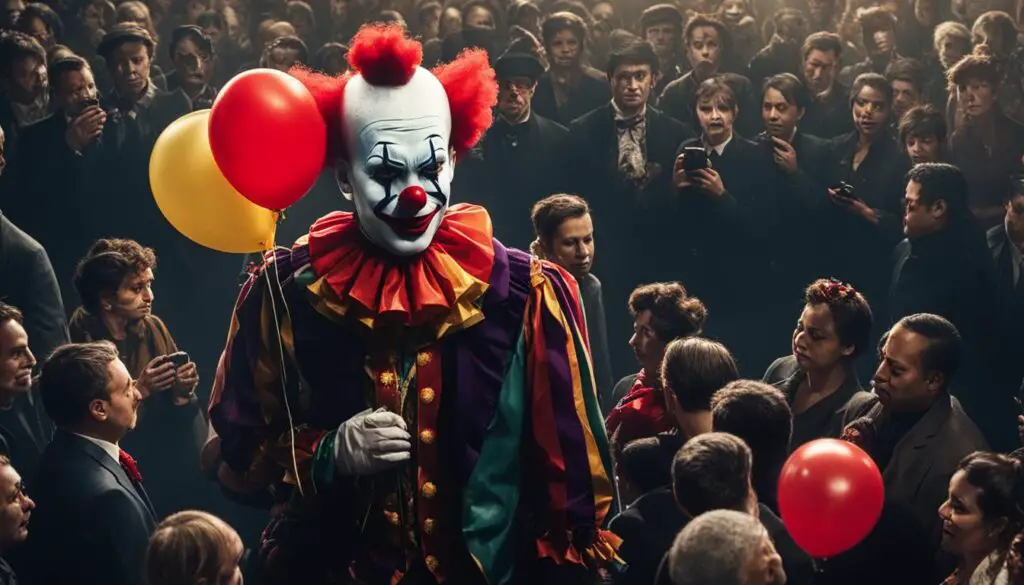The sudden appearance of clowns in unusual locations, coupled with reports of frightening encounters, has sparked curiosity and fear in recent years. This phenomenon, known as clown sightings, has captivated the public’s attention and provoked a range of emotions. In this article, we will delve into the reasons behind these mysterious appearances and examine the psychological and cultural factors contributing to the fear and fascination with clowns.
Key Takeaways
- Clown sightings have caused widespread anxiety and fear due to their unusual and unpredictable nature.
- The fear of clowns, known as coulrophobia, is a common phobia that often develops in childhood.
- The media portrayal of clowns as sinister and dangerous has further fueled negative perceptions.
- Clowns have a long-standing place in cultural history, both as sources of entertainment and symbols of mystery.
- The intersection of psychology, culture, and media plays a crucial role in shaping our perceptions and fears surrounding clowns.
The Psychological Perspective on Clown Sightings
The fear of clowns, known as coulrophobia, is a common phobia that often develops in childhood. Clowns can be unsettling to some people because their exaggerated appearance and unpredictable behavior can create a sense of unease and confusion. Additionally, the inability to read genuine emotions on a clown’s face can be disconcerting, as it leaves people uncertain about what the clown is feeling or what to expect.
The media portrayal of clowns as sinister and dangerous, as seen in movies such as Stephen King’s “IT,” has further contributed to the fear and negative perception of clowns in popular culture. The dichotomy between their comedic image and the underlying potential for harm has been explored in various forms of media, deepening the psychological impact on those with clown phobia.
It is important to note that not everyone experiences fear or phobia of clowns, and reactions can vary from person to person. For some, clowns may evoke feelings of joy and amusement, while for others, they instill a deep sense of fear and unease. The psychological response to clowns is influenced by a multitude of factors, including personal experiences, cultural upbringing, and individual predispositions.
Fear of Clowns in Popular Culture
Clown phobia has been perpetuated and reinforced by its portrayal in popular culture. Movies, TV shows, and literature often depict clowns as sinister and malevolent figures, tapping into the primal fears of the audience. Stephen King’s “IT,” for example, has become an iconic representation of the fear of clowns, with Pennywise the Dancing Clown haunting the nightmares of countless individuals.
Such media depictions not only validate existing fears but also create new ones. The association of clowns with danger and evil has become deeply ingrained in popular culture, making it increasingly challenging to separate the fictionalized portrayals from reality.
“We all float down here!” – Pennywise the Dancing Clown
Psychology Behind Clown Phobia
Clown phobia can be attributed to various psychological factors. The uncanny valley theory suggests that the exaggerated features of clowns, such as oversized smiles, brightly colored makeup, and extravagant costumes, can trigger feelings of unease. These exaggerated features deviate from the normal human appearance, making clowns seem both familiar and unfamiliar at the same time.
The unpredictability and spontaneity of clown behavior can also contribute to the fear experienced by some individuals. Clowns often engage in exaggerated gestures and unconventional actions, making it difficult to predict their next move. This unpredictability can create a sense of anxiety and discomfort, as individuals feel uncertain about what the clown might do.
Overcoming the Fear
For individuals who suffer from coulrophobia, overcoming the fear of clowns can be a challenging but achievable task. Cognitive-behavioral therapy (CBT) is often used to help individuals modify their negative thoughts and associations with clowns. Exposure therapy, a common technique used in CBT, gradually exposes individuals to their feared object or situation, allowing them to develop new, positive associations.
The Cultural Fascination with Clowns and Societal Impact
Clowns have long held a significant place in cultural history and have been both loved and feared. They have been a source of entertainment and laughter, but also perceived as mysterious and even sinister figures. The tension between the exaggerated appearance of clowns and the human emotions they conceal has fascinated and intrigued people for centuries.

The recent wave of clown sightings and the subsequent media coverage have had a societal impact, leading to school lockdowns, increased anxiety, and even bans on clown costumes and masks in some areas. The proliferation of social media has also played a role in spreading rumors and causing mass hysteria related to clown sightings.
Media Portrayal of Clowns
The media has played a significant role in shaping the perception of clowns in popular culture. Movies such as Stephen King’s “IT” have portrayed clowns as sinister and dangerous, reinforcing the fear and negative associations often associated with clowns. These portrayals have influenced public opinion and contributed to the fear and anxiety surrounding clowns in recent years.
The tension between the exaggerated appearance of clowns and the human emotions they conceal has fascinated and intrigued people for centuries.
Furthermore, the cultural fascination with clowns has been evident in various forms of media, including literature, art, and entertainment. From the iconic and beloved character of the circus clown to the complex and tortured portrayal of clowns in contemporary literature and film, the enduring allure of clowns continues to captivate audiences.
| Cultural Fascination with Clowns | Societal Impact of Clown Sightings |
|---|---|
| Historical significance in cultural history | School lockdowns and increased anxiety |
| Source of entertainment and laughter | Bans on clown costumes and masks |
| Mysterious and sinister figures | Spread of rumors and mass hysteria |
The societal impact of clown sightings highlights the complex interplay between culture, psychology, and media. The fascination with clowns persists, even as the fear and anxiety surrounding them continue to grow in certain contexts. It is a testament to the enduring power and influence of clowns on our collective imagination.
Conclusion
The rising trend of clown sightings in recent years has created a ripple of fear and fascination among the public. Although the motivations behind these sightings vary, it is evident that psychological factors, societal anxieties, and media portrayals of clowns play a significant role in this phenomenon.
The fear of clowns stems from the unpredictability and ambiguity they represent. Their exaggerated appearance and manic behavior make it challenging to discern their true emotions, leaving people feeling uneasy and uncertain. It is crucial to remember that not all clowns are sinister or dangerous, and the fear or phobia of clowns is not universal.
This growing trend of clown sightings also emphasizes the power of social media in spreading rumors and inciting mass hysteria. The ease and speed with which information circulates online can magnify people’s fears and contribute to the amplification of these sightings.
In conclusion, the rise in clown sightings highlights the intricate interplay between psychology, culture, and media. Understanding the underlying psychological factors that contribute to the fear of clowns can help individuals navigate their anxieties in a more informed way. By separating the fictional portrayals of clowns from real-life individuals, we can cultivate a more balanced perspective on these enigmatic figures that have both entertained and unsettled us throughout history.
FAQ
Why did clown sightings become a trend?
The trend of clown sightings emerged in 2016 due to reports of people dressed as evil clowns appearing in unusual locations. It started in Green Bay, Wisconsin as a marketing stunt for a horror film and quickly spread to other cities and countries, fueled by social media.
What is coulrophobia?
Coulrophobia is the fear of clowns. It is a common phobia that often develops in childhood. The exaggerated appearance and unpredictable behavior of clowns can create unease and confusion, while media portrayals of sinister clowns have further contributed to the fear.
Why are clowns fascinating to people?
Clowns have a significant place in cultural history and have been both loved and feared. The tension between their exaggerated appearance and concealed emotions has intrigued people for centuries. They have been a source of entertainment, but also perceived as mysterious and even sinister figures.
What is the societal impact of clown sightings?
The recent wave of clown sightings had a societal impact, leading to school lockdowns, increased anxiety, and even bans on clown costumes and masks in some areas. Social media played a role in spreading rumors and creating mass hysteria related to clown sightings.
What is the psychology behind the fear of clowns?
The fear of clowns can be attributed to the inability to read genuine emotions on their faces and their often manic behavior. The uncertainty and unpredictability they represent can create discomfort and fear in individuals. However, it is important to note that not all clowns are sinister or dangerous, and not everyone experiences fear or phobia of clowns.
Why did the media portrayal of clowns contribute to the fear?
The media portrayal of clowns as sinister and dangerous, as seen in movies like Stephen King’s “IT,” has contributed to the fear and negative perception of clowns in popular culture. The portrayal of clowns as villains or monsters has reinforced the association between clowns and fear.
Why did the clown sightings result in fear and anxiety?
The clown sightings observed in recent years resulted in fear and anxiety due to their unexpected nature and the uncertainty they created. The fear of the unknown, the associations with violence or harm, and the potential for actual harm or harassment from these sightings contributed to the increased anxiety and fear.

